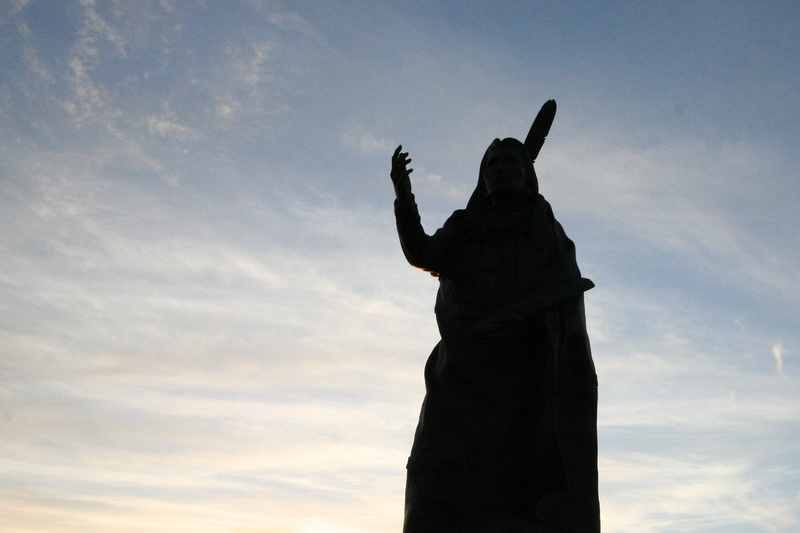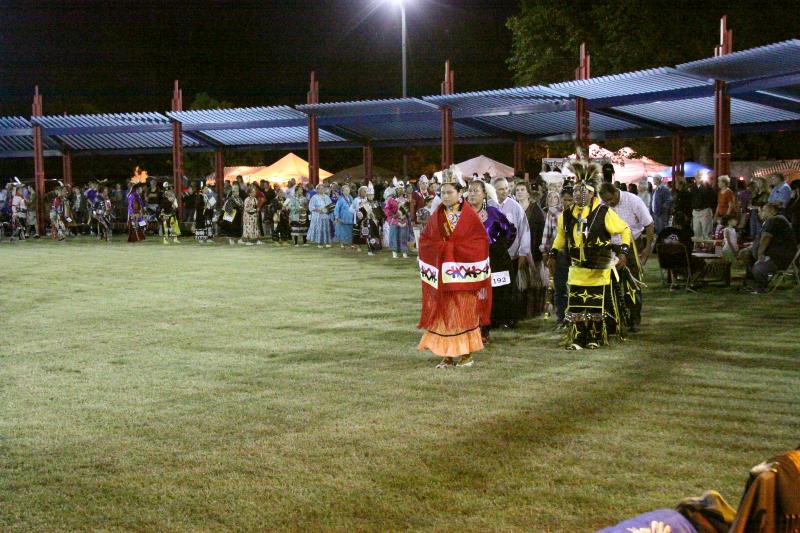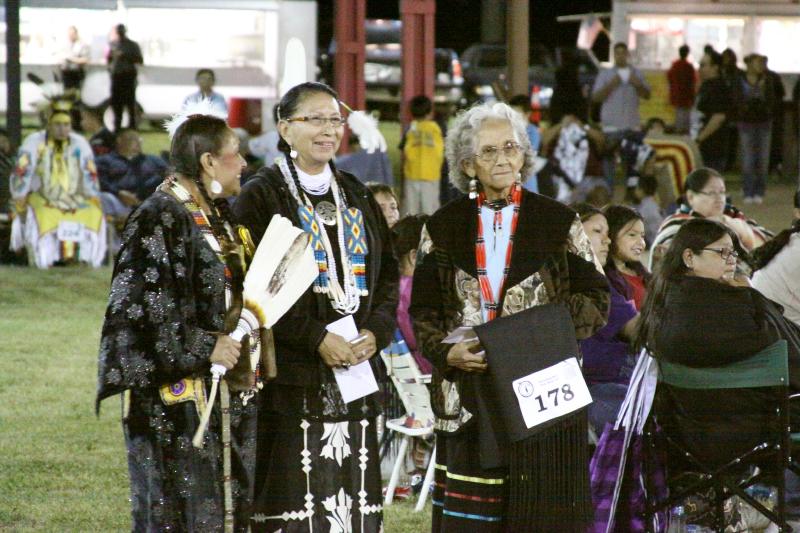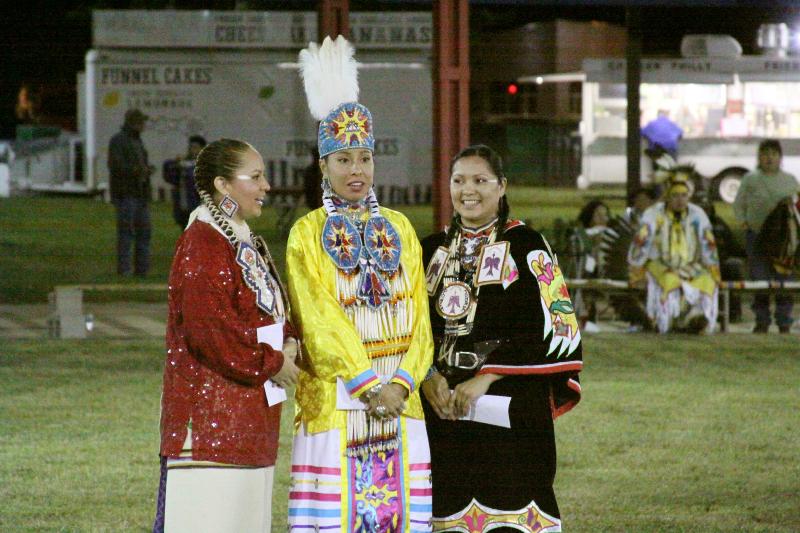
| By Admin1 (admin) (199.253.177.105) on Thursday, January 28, 2010 - 9:32 am: Edit Post |

Last September my wife and I attended the annual Standing Bear Pow Wow hosted by the Kaw Nation, Osage Nation, Otoe-Missouria Nation, Pawnee Nation, Ponca Nation, and Tonkawa Nation and were enormously impressed by this gathering where people met to dance, sing, socialize, and honor American Indian culture. Take a look a our photos from the pow wow and watch our slide show of the pow wow.
We recently sat down with TL Walker, the Executive Director of the Standing Bear Foundation, and with Oliver Littlecook, a member of the Ponca Nation who was recently elected to the Ponca Nation Business Council and who officiated as one of the two Masters of Ceremony of the 2009 Standing Bear Pow Wow. We talked to Walker and Littlecook about the mission of the Standing Bear Foundation, how the Standing Bear Pow Wow has evolved over the years, what goes into putting together the Pow Wow, what the future holds for the Standing Bear Pow Wow, and the role the Pow Wow plays in building bridges between the native American and non-native American communities.

Oliver Littlecook says that the Standing Bear Pow Wow grew out of the controversy surrounding the dedication of the statue in front of the Ponca City Civic Center commemorating the land run when the Cherokee Outlet was opened for settlement in 1893 and the attitude of members of the Ponca Tribe to the memorial. "To us as a people, that was a devastating time for us. That broke up all of our land," says Littlecook "If you want to honor someone, why not pick someone of our heritage." That led to discussion and dialog and that is how a group was formed "with Mr. Carl Renfro and some other townspeople who started to formulate the idea of commemorating a Native American," says Littlecook. "They consulted with the local tribal people and tribal leaders and picked someone who would represent the Indian in a positive way."
"That's how they chose Standing Bear, one of our leaders who was forcibly removed from our homeland in the landmark court case," adds Littlecook. "Standing Bear was not only a Ponca Indian, one of our chiefs, but he represented all Indians."
“The Standing Bear Foundation was born to bring the two cultures together” says Walker, “Having the Pow Wow is a way for the two cultures to come together in a social setting. The Pow Wow wasn't a committee meeting, there wasn't any agenda that had to be filled, it was bringing them together in a social setting that was cultural by nature.”

The first Standing Bear Pow Wow was in October 1994 and that was before there was anything at the park – no museum, no statue. "We were originally across the highway," says Littlecook. "There were still fields, and trees, and hay bales and they just cleared out an area to have the dance."
The first Pow Wow was held in a little grove of trees which is now the memorial sitting area. “It began just as a recognition of what an important social event the Pow Wow could be and it was one of the first attempts to really bring the two cultures together,” says Walker. The Pow Wow continued in 1995 and then in 1996 when the statue was unveiled the Pow Wow grew considerably. That year it rained and although it turned out to be a beautiful day for the unveiling of the statue, the Pow Wow had to be held inside Hutchins memorial, the only time that the Pow Wow had to be moved indoors.
"The Ponca Nation has its own Pow Wow," says Littlecook. "The Pawnee Nation has its own Pow Wow. Each one of the six North-Central Tribes has its own Pow Wow. But the way the Standing Bear Pow Wow was set up, they wanted to give each tribe in this area the opportunity to showcase its own tribal history and traditions. We choose Pow Wows because that was more of a general social event where we could involve a lot of the public. In the beginning they rotated it, so the Foundation committee said, ok, the Ponca Tribe is going to run this particular Pow Wow. However, you want to do it, it's your Pow Wow. The next year, they rotated it to another tribe. Now the six tribes are working together to do each Pow Wow. There is a permanent Foundation Committee that is TL, and Carl Renfro and other people on the permanent foundation board, plus people from Ponca City, and each tribe has the opportunity to appoint members to serve on the committee."
“We did that for several years, rotating through all of the six tribes with several of the tribes even hosting the Pow Wow more than once but in 2005 instead of rotating it, we started asking each tribe to send a member who would represent each tribe on the tribal host committee. That was our first attempt to have a representative from all of the tribes which is really where were headed all along. This is truly where we wanted to be having all the the tribes working together. Now it seems that each year someone from the tribes will mention that this is a special time during the year that the six tribes come together to work together on a major project.”

In 2005 the permanent Pow Wow arbor was completed and used for the Pow Wow for the first time. Until then a very traditional Brush Arbor was used as a temporary structure to house the Pow Wow. “We tried to respect as many of the traditional ways of construction as we could which meant finding branches with natural forks in them for the uprights and then using willow branches and we found that the arbor had to be rebuilt almost every year and that we were depleting the immediate area and supply of willow branches, so in 2005 we built a permanent arbor," says Walker.
How has the Pow Wow changed? “I think there is a lot more trust now. In the early days we had so much to learn," says Walker. "As we have gotten better at what we do, the tribes have learned to trust that the foundation will really try to safeguard their traditions.”
"I think there is really a good cooperation and I think the city of Ponca City has accepted the Pow Wow and are supportive of it and of what the Foundation is trying to do," says Littlecook. "I think that has brought us together. I have seen it grow in a good positive manner."

The planning that goes into the Pow Wow is extraordinary. “I was at the Marland Mansion before I was here” says Walker, “so I did Octoberfest seven times and it has been interesting to see the difference in the two types of events.” Planning starts in February with a big meeting when the tribal representatives come together to decide on a schedule. After the schedule, the biggest thing that the committee has to do is decide on the head staff including the Masters of Ceremony, the arena director, the head singer, the head man and the head lady dancer, the water carrier, the host gourd group and the color guard. “These people are critical to bringing all the tribal representatives together so going through the process and figuring out who is going to hold those important positions in the Pow Wow is a big deal,” says Walker. “Everyone throws names on the table and we all try to make sure that we have every tribe represented in our head staff, so they can go back out and start extending invitations to those people to come and be part of the Pow Wow. Selection of the head staff makes or breaks the Pow Wow.”
Littlecook, one of the two Masters of Ceremony for the 2009 Standing Bear Pow Wow, adds that the educational role of the Pow Wow is very important. "The role of the Masters of Ceremony is not only to oversee control and discipline within the arena," says Littlecook, "but to educate the public about the traditions of Native American Nations." Nationwide, there are different types of Pow Wows says Littlecook. "Some of the Pow Wows are more commercialized. In a big commercial kind of Pow Wow there is really no history behind it so in those kinds of Pow Wows the Master of Ceremonies are more announcer types," says Littlecook. "However the focus of the Standing Bear Pow Wow is not commercialization but education so the Master of Ceremonies needs to talk about the historical aspects of the Pow Wow and educate the public on Native American values and traditions."
The detailed logistics of putting on the Pow Wow are phenomenal. “We have a book that we have developed over the years that is divided into sections on each aspect of the Pow Wow that contains the list of all the things that need to be done for the Pow Wow,” says Walker. “The book is composed of minute details. For example, you have to get the lapel pin that the Pow Wow princess uses to pin her sash when she is crowned.” The traditional meal is another major undertaking. “Each year we feed 750 to 1,000 people and have them through the line in under an hour.”
“It is little details - and there are pages and pages of them - that you have to get right,” says Walker. “We work on those details every day. One of the things that we will be doing in a few weeks is getting together and going over the Pow Wow we just had to see what we may have forgotten or need to add or change for next year’s Pow Wow.”

What is the future of the Pow Wow? “I think that sometimes in life we get confused about means and ends,” says Walker. “Some people may look at the Pow Wow as the end that we are working towards and that all the work leading up to the Pow Wow are the means to get to that end. But that is not the case – in fact, it is the exact opposite. The Pow Wow is the means and all of the work that we do with the six tribes, all of the hurdles that we get over, that is the end. We would not have that opportunity to work together if it were not for the Pow Wow. If we had had a complete rain-out for the Pow Wow and not had the opportunity to do the Pow Wow at all – the Pow Wow would still have been a success because of what had gone into getting to that point. That is the important part. When we have a problem, the way we work together to resolve that problem is our essential goal. It is not only about the Pow Wow itself, but it affects how we move forward with those tribal members for the rest of the time that we work together.”
“I think that we will continue to make it as smooth as possible” says Walker. “I don't like a lot of glitches because I think that the less glitches there are, the more it makes it possible for these two groups to feel good about the other one. I want the non-native American volunteers to feel really good about the work that they do and vice versa. I want to enhance that feeling of trust so what I think will happen is we will continue to get better at the details, better at not having little mistakes, because it is those little things that trip you up. As we have less and less glitches, I think that the tribal members will perceive that we do respect those little details in their culture and that we are going to rise to the challenge and they will trust us more so that when there are problems with other issues or any of the other problems we have in the community, I think that that trust will carry over.”

How has attendance increased at the Standing Bear Pow Wow since its beginning and what do you think the future holds in terms of attendance? "I think it is about the right size," says Littlecook. "I think maybe we could do things a little differently to bring different attractions but the size of it is about right."
“We are getting more people coming in to watch,” says Walker. “Ten years ago we would have had 1,000 people attending and although we don't keep an official count of the number of people who attend the Standing Bear Pow Wow, our food vendors, who make it their business to be able to evaluate a crowd, tell us that this year we probably had between 3,000 and 5,000 people attend the Pow Wow.”
“We will have some more growth in the Standing Bear Pow Wow but it will be controlled growth,” says Walker. “When we first started the Pow Wow everybody thought that this was going to be commercialized and there are still some who think that bigger is always better. But it takes a lot of effort to get big and to commercialize and that is not what we are trying to do.”
"Here among the North Central tribes, we are probably more traditional than other tribes," says Littlecook. "If you get away from that and become more commercialized, then it becomes more about dancing for the prize money instead of for the traditions. So in that sense, I don't want to see the Pow Wow get any bigger than it is now. If you start getting too big, that's when you start to see it get more commercialized and the Pow Wow loses its meaning."
“We are not trying to become like the annual Pow Wow put on by the Intertribal Indian Club in Tulsa with 30,000 people attending” adds Walker. “Our focus is on the six tribes and the filter through which we see everything is education not tourism. I think that as long as we keep expending our effort on the things that answer our mission of education that will keep us true to what we need to be. If we can keep everyone's vision focused on education and being true to what it is, then I think that is our best defense against over-commercialization.”
"They have put me on the Standing Committee for the Pow Wow," says Littlecook, "and part of my suggestions for the Pow Wow is that perhaps we should expand it to one more day and provide more activities for the children - little games and educational activities that highlight Native American culture. I think we should keep the Pow Wow like it is but provide additional activities."

"This is our history. We pass it down from generation to generation among ourselves through word of mouth and story telling," says Littlecook. "Not too many people realize this, but the concept of Pow Wow comes from the Ponca Tribe. The Poncas are the actual originators of today's Pow Wow. We have a saying that says that 'We may not be the originators, but there is no one here before us.' The components of the Pow Wow actually derive from the religion that we had that we call He-losh-ka. Even that word is lost in antiquity itself. He-losh-ka - that was the long time religion. The majority of our history is tied up in our songs."
But the Pow Wow is just one piece of the larger picture of building bridges of understanding between the two communities. “My big passion is the work that I do in the schools” says Walker. “Every year before the start of the school year the teachers in the Ponca City School System have a professional development process that they go through that includes a cultural diversity component and this year two of the schools elected to have me do their cultural diversity component. I met with seventy teachers who each have 20 students in their classrooms so in those two days I perhaps had the opportunity to touch 1,400 lives.”
“As a result of the relationships with tribal members and elders which have evolved during the various Pow Wows, we have a rich resource of people whom we can consult for guidance to help us make sure we’re communicating things correctly,” says Walker. “My husband is a second grade teacher and over the years he has become a little bit frustrated teaching cultural diversity to his students. One of his favorite books that he has used to teach cultural diversity is an older book that has a lot of inappropriate references in it and this is a book that in the past he has read aloud to his students. But last year as he began reading the book aloud to his students he realized as he was reading that some of the terms were inappropriate and started trying to correct them as he read the book aloud. It finally got to the point where he realized that he is not going to be able to use this particular book in his classes any longer. “
“When that book was written it was maybe ok to call native American women by a certain term, but it isn't ok any more and you can't explain that to a second grader,” says Walker. “That's not what a second grader is going to take away from the reading experience and that’s what I talk to teachers about. When I talk to the teachers I say that you are going to feel like I am taking everything away from you that you enjoy using in the classroom. But I am also offering to do lesson plans for you - to do whatever will help you put in new things because I really want kids to grow up with an appreciation for cultural diversity so we need to talk to kids about cultural differences when they are young enough that it is ok to be different.”

"I attended school in Ponca City and graduated in 1972," says Littlecook. "In school, we were never taught anything about our history or culture. My oldest brother is 75 and I am 56 - there is a big gap - and in our home, a lot of that information that was given to my brothers and sisters came to me very fragmented because when I was born, that's when my parents stopped speaking our language in the home. Back in the 40's and 50's it was really unpopular to be Indian. It was pounded into their heads that you have to get rid of your culture. But in the last few years society has come a long way to recognizing the value of Native American culture and history so I am supportive of Carl and TL and the city of Ponca City in embracing that part of our tradition."
“What I have learned is that we come from a culture that has a history of not understanding other cultures and not appreciating the good things about cultural diversity,” says Walker. “That makes me more dedicated to changing things if I can so that future generations are not going to be in the position that we are in of saying ‘I really didn't grow up with an appreciation for other cultures.’ We can all thank the Pow Wow as the vehicle through which we forge an understanding and an appreciation for our respective cultures."
"The community of Ponca City and the community of all six tribes need to use the Pow Wow to celebrate together and embrace each other's culture with understanding," says Littlecook. "The work of the Foundation shows me what these communities working together can achieve. People came together twenty years ago to make some long range projections and to set down a strategy and plan to achieve them. Over the years the park was created, then the statue, then the museum. That is evidence that if we work together we can achieve these things. Now we can take those feelings to another avenue whether it be economic development or whatever we choose to do. It shows that it can be done, that there is another avenue we can take with understanding and respect between the cultures."

Thanks to the Kaw Nation, Osage Nation, Otoe-Missouria Nation, Pawnee Nation, Ponca Nation, and Tonkawa Nation for their hospitality in putting on the Standing Bear Pow Wow.
Thanks to Carl Renfro and the Standing Bear Foundation for organizing the Standing Bear Pow Wow.
Our special thanks to TL Walker, Executive Director of the Standing Bear Foundation and to Oliver Littlecook, Master of Ceremonies of the 2009 Standing Bear Pow Wow for their assistance in writing this story.
Take a look at our photos of the Standing Bear Pow Wow in September 2009 and watch a slide show of the pow wow.